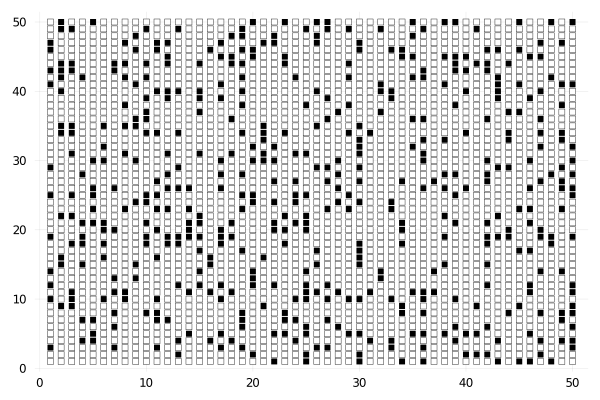Conway's game of life

It is also available from the Models module as Models.game_of_life.
using Agents, Plots1. Define the rules
Rules of Conway's game of life: DSRO (Death, Survival, Reproduction, Overpopulation). Cells die if the number of their living neighbors is <D or >O, survive if the number of their living neighbors is ≤S, come to life if their living neighbors are ≥R and ≤O.
rules = (2, 3, 3, 3)2. Build the model
First, define an agent type. It needs to have the compulsary id and pos fields, as well as an status field that is true for cells that are alive and false otherwise.
mutable struct Cell <: AbstractAgent
id::Int
pos::Dims{2}
status::Bool
endThe following function builds a 2D cellular automaton. rules is of type Tuple{Int,Int,Int,Int} representing DSRO.
dims is a tuple of integers determining the width and height of the grid environment. metric specifies whether cells connect to their diagonal neighbors.
This function creates a model where all cells are "off".
function build_model(; rules::Tuple, dims = (100, 100), metric = :chebyshev)
space = GridSpace(dims; metric)
properties = Dict(:rules => rules)
model = ABM(Cell, space; properties)
idx = 1
for x in 1:dims[1]
for y in 1:dims[2]
add_agent_pos!(Cell(idx, (x, y), false), model)
idx += 1
end
end
return model
endNow we define a stepping function for the model to apply the rules to agents.
function ca_step!(model)
new_status = fill(false, nagents(model))
for agent in allagents(model)
nlive = nlive_neighbors(agent, model)
if agent.status == true && (nlive ≤ model.rules[4] && nlive ≥ model.rules[1])
new_status[agent.id] = true
elseif agent.status == false && (nlive ≥ model.rules[3] && nlive ≤ model.rules[4])
new_status[agent.id] = true
end
end
for k in keys(model.agents)
model.agents[k].status = new_status[k]
end
end
function nlive_neighbors(agent, model)
neighbor_positions = nearby_positions(agent, model)
all_neighbors = Iterators.flatten(ids_in_position(np,model) for np in neighbor_positions)
sum(model[i].status == true for i in all_neighbors)
endnow we can instantiate the model:
model = build_model(rules = rules, dims = (50, 50))AgentBasedModel with 2500 agents of type Cell space: GridSpace with size (50, 50), metric=chebyshev and periodic=true scheduler: fastest properties: Dict(:rules => (2, 3, 3, 3))
Let's make some random cells on
for i in 1:nagents(model)
if rand() < 0.2
model.agents[i].status = true
end
end3. Animate the model
We use the plotabm function to create an animation.
ac(x) = x.status == true ? :black : :white
anim = @animate for i in 0:100
i > 0 && step!(model, dummystep, ca_step!, 1)
p1 = plotabm(model; ac = ac, as = 3, am = :square, showaxis = false)
endWe can now save the animation to a gif.
gif(anim, "game_of_life.gif", fps = 5)